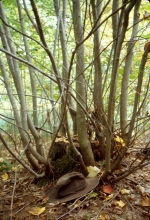You are here
New Study: Carbon Age in Sprouting Trees

A comparative study of red maple trees at the Harvard Forest and at Bartlett Experimental Forest in New Hampshire sheds new light on how trees allocate carbon throughout their life cycle--including just after they have been cut. The researchers used radiocarbon dating to "age" the carbon in new sprouts that emerge from stumps when trees are harvested.
The two sites showed marked differences. Harvard Forest collaborator Andrew Richardson explains: "At Harvard Forest, the sprout carbon was only a few years old, though in the White Mountains we had sprout carbon that was more than a decade old."
The team also analyzed tree ring widths to create a new conceptual model for how carbohydrate reserves are linked to tree growth and metabolism.

